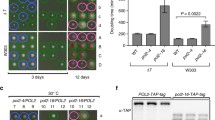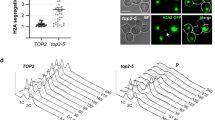Summary
We report on the characterization of the yeast prp20-1 mutant. In this temperature-sensitive mutant, multiple steps of mRNA metabolism are affected. The prp20-1 mutant strain showed alterations in mRNA steady-state levels, defective mRNA splicing and changes in transcription initiation or termination when shifted from the permissive to the non-permissive temperature. In addition, a change in the structure of the nucleus in these cells became apparent. Electron microscopy revealed an altered structure of the nucleoplasm of prp20-1 mutant cells when grown at the no-permissive temperature that was not observed in cells grown at the permissive temperature or in wild-type cells. The wild-type PRP20 gene was isolated and sequenced. The putative PRP20 protein has a molecular weight of 52 kDa. We found that the PRP20 gene is identical to the yeast SRM1 gene (Clark and Sprague 1989). In addition, the PRP20 protein sequence shows significant sequence similarity to the human RCC1 protein (Ohtsubo et al. 1987). This protein has been implicated in the control of chromosome condensation. Based on the phenotype of the prp20-1 mutant and the observed sequence similarity to the human RCC1 protein, we postulate that the yeast PRP20 protein is involved in the control of nuclear organization.
Similar content being viewed by others

References
Aebi M, Hornig H, Padgett RA, Reiser J, Weissmann C (1986) Sequence requirements for splicing of higher eukaryotic nuclear pre-mRNA. Cell 47:555–565
Beyer AL, Osheim YN (1988) Splice site selection, rate of splicing, and alternative splicing on nascent transcripts. Genes Dev 2:754–765
Boeke JD, LaCroute F, Fink GR (1984) A positive selection for mutants lacking orotidine-5′-phosphate decarboxylase activity in yeast: 5-fluoro-orotic acid resistance. Mol Gen Genet 197:345–346
Clark KL, Sprague Jr GF (1989) Yeast pheromone response pathway: Characterisation of a suppressor that restores mating to receptorless mutants. Mol Cell Biol 9:2682–2694
Clark MW (1990a) Nucleolar-specific silver staining for optical and electron microscopy. Methods Enzymol, in press
Clark MW (1990b) Immunogold labelling of yeast cells. Methods Enzymol, in press
Clark MW, Abelson J (1987) The subnuclear localisation of yeast tRNA ligase. J Cell Biol 105:1515–1526
Feinberg AP, Vogelstein B (1983) A technique for radiolabeling DNA restriction endonuclease fragments to high specific activity. Anal Biochem 132:6–13
Green MR (1986) Pre-mRNA splicing. Annu Rev Genet 20:671–708
Guthrie C, Patterson B (1988) Spliceosomal snRNAs. Annu Rev Genet 22:387–420
Ito H, Fukuda Y, Murata K, Kimura A (1983) Transformation of intact yeast cells treated with alkali cations. J Bacteriol 153:161–168
Kai R, Ohtsubo M, Sekiguchi M, Nishimoto T (1986) Molecular cloning of a human gene that regulates chromosome condensation in interphase nuclei. Mol Cell Biol 6:2027–2032
Lawrence JB, Singer RH, Marselle LM (1989) Highly localized tracks of specific transcripts within interphase nuclei visualized by in situ hybridization. Cell 57:493–502
Legrain P, Rosbash M (1989) Some cis- and trans-acting mutants for splicing _target pre-mRNA to the cytoplasm. Cell 57:573–583
Lustig A, Lin RJ, Abelson J (1986) The yeast RNA gene products are essential for mRNA splicing in vitro. Cell 47:953–963
Mager WH (1988) Control of ribosomal protein gene expression. Biochim Biophys Acta 949:1–15
Nishimoto T, Eilen E, Basilico C (1978) Premature chromosome condensation in a tsDNA− mutant of BHK cells. Cell 15:475–483
Nishimoto T, Ishida R, Ajiro K, Yamamoto S, Takahashi T (1981) The synthesis of protein(s) for chromosome condensation may be regulated by a post-transcriptional mechanism. J Cell Physiol 109:299–308
Ohtsubo M, Kai R, Furuno N, Sekiguchi T, Sekiguchi M, Hayashida H, Kuma K, Miyata T, Fukushige S, Murotsu T, Matsubara K, Nishimoto T (1987) Isolation and characterisation of the active cDNA of the human cell cycle gene (RCC1) involved in the regulation of onset of chromosome condensation. Genes Dev 1: 585–593
Padgett RA, Grabowski PJ, Konarska MM, Seiler S, Sharp PA (1986) Splicing of messenger RNA precursors. Annu Rev Biochem 55:1119–1150
Rosbash M, Harris PKW, Woolford Jr JL, Teem JL (1981) The effect of temperature-sensitive RNA mutants on the transcription products from cloned ribosomal protein genes of yeast. Cell 24:679–686
Rose MD, Novick P, Thomas JH, Botstein D, Fink GR (1987) A Saccharomyces cerevisiae genomic plasmid bank based on a centromere-containing shuttle vector. Gene 60:237–243
Sachs AB, Bond MW, Kornberg RA (1986) A single gene from yeast for both nuclear and cytoplasmic polyadenylate-binding proteins. Domain structure and expression. Cell 45:827–835
Schultz LD, Friesen JD (1983) Nucleotide sequence of the tcm1 gene (ribosomal protein L3) of Saccharomyces cerevisiae. J Bacteriol 155:8–14
Sherman F, Fink GR, Hicks JB (1983) Methods in yeast genetics: laboratory manual. Cold Spring Harbor Laboratory Press, Cold Spring Harbor, New York
Teem JL, Abovich N, Käufer NF, Schwindinger WF, Warner JR, Levy A, Woolford J, Leer RJ, Van Raamsdonk-Duin MMC, Mager WH, Planta RJ, Schultz L, Friesen JD, Fried H, Rosbash M (1984) A comparison of yeast ribosomal protein gene DNA sequences. Nucleic Acids Res 12:8295–8312
Vijayraghavan U, Abelson J (1989) Pre-mRNA splicing in yeast. In: Eckstein F, Lilley DT (eds) Nucleic acids and molecular biology, vol 3. Springer Verlag, Berlin Heidelberg New York, pp 197–215
Vijayraghavan U, Company M, Abelson J (1989) Isolation and characterisation of pre-mRNA splicing mutants in Saccharomyces cerevisiae. Genes Dev 3:1206–1216
Wittekind M, Memet S, Buhler JM, Nomura M (1990) Conditional expression of RPA190, the gene encoding the largest subunit of yeast RNA polymerase I: Effect of decreased rRNA synthesis on ribosomal protein synthesis. Mol Cell Biol 10:2049–2059
Author information
Authors and Affiliations
Additional information
Communicated by C.P. Hollenberg
Rights and permissions
About this article
Cite this article
Aebi, M., Clark, M.W., Vijayraghavan, U. et al. A yeast mutant, PRP20, altered in mRNA metabolism and maintenance of the nuclear structure, is defective in a gene homologous to the human gene RCC1 which is involved in the control of chromosome condensation. Molec. Gen. Genet. 224, 72–80 (1990). https://doi.org/10.1007/BF00259453
Received:
Issue Date:
DOI: https://doi.org/10.1007/BF00259453



